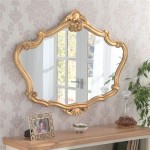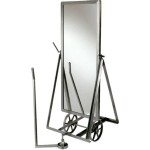One-Way Mirrors: Unveiling the Illusion
One-way mirrors, also known as two-way mirrors or semi-transparent mirrors, are intriguing surfaces that appear to be a regular mirror from one side while functioning as a transparent window from the other. This effect is frequently employed in surveillance situations, interrogation rooms, and various other applications where observation without being observed is desired. The underlying principles that enable this seemingly paradoxical behavior are based on the control of light transmission and reflection, and are more nuanced than simple "magic." Understanding the mechanics behind one-way mirrors requires an examination of their physical properties, the role of light, and the conditions necessary for the illusion to function effectively.
The core component of a one-way mirror is not a substantially different type of glass. It is typically a sheet of glass with a thin, semi-transparent reflective coating applied to one side. This coating isn't fully opaque like a conventional mirror, but rather a fine layer of metal – often aluminum – that has been applied through a process like sputter deposition. The thickness of this metallic layer is crucial. If the layer were too thick, it would behave like a regular mirror, reflecting nearly all the light. If it were too thin, it would be almost entirely transparent. The goal is to achieve a balance where a significant portion of the light is reflected, while another portion is transmitted.
The magic of the one-way mirror lies not just in the mirror itself, but also in the lighting conditions on either side. For the illusion to work convincingly, there needs to be a substantial difference in light intensity between the two rooms. The room designed for observation (the "dark" room) needs to be significantly darker than the room being observed (the "bright" room). This difference in illumination exploits how the human eye perceives light and contributes to the overall effect.
The Role of Light Reflection and Transmission
When light strikes the surface of a one-way mirror, several things happen. A portion of the light is reflected, a portion is transmitted through the glass, and a small amount is absorbed into the coating. The amount of light reflected versus transmitted is determined by the thickness and composition of the reflective coating. A thicker coating reflects more light, while a thinner coating allows more light to pass through. The objective in manufacturing a one-way mirror is to achieve a reflection-to-transmission ratio that is suitable for creating the desired illusion. A typical ratio might be around 70% reflection and 30% transmission, although this can vary depending on the intended application.
From the "bright" room's perspective, the observer sees a reflection of themselves and their surroundings. This is because the relatively strong light within the bright room is reflected off the surface of the mirror, creating a clear image. The transmitted light from the dark room is present, but it is significantly weaker and overwhelmed by the brighter reflected light. Essentially, the bright light reflected from the bright room dominates the visual experience and renders the transmission from the dark room mostly imperceptible.
Conversely, from the "dark" room's perspective, the observer sees through the glass into the bright room. This is because the significantly lower light level in the dark room means that very little light is reflected back towards the observer. The transmitted light from the bright room, even though partially attenuated by the semi-reflective coating, is now the dominant source of light entering the observer's eyes. Therefore, the observer perceives the glass as a window, allowing them to see the activity in the brighter room without being easily detected.
It is important to note that a small amount of light will always be reflected from the dark room's side. If the dark room is not sufficiently dark, this reflected light can become noticeable, compromising the one-way mirror effect. This is why maintaining a substantial light differential is crucial for the illusion to be effective.
The Significance of Lighting Conditions
The effectiveness of a one-way mirror depends critically on maintaining a substantial difference in light intensity between the two rooms. The general guideline is that the room to be observed should be significantly brighter – ideally several times brighter – than the observation room. This lighting disparity is the key to manipulating how the human eye perceives the reflected and transmitted light.
Consider what happens when the lighting conditions are reversed. If the observation room is brighter than the room being observed, the effect of the one-way mirror is lost or even reversed. The person in what was the “bright” room now sees a reflection of the brighter observation room superimposed on the view of their own room. The mirrored surface, in essence, becomes a partially reflective window from both sides. The desired illusion is completely destroyed. This is because the reflected light from the now brighter observation room overwhelms the transmitted light from the formerly bright room.
Therefore, careful control of the lighting is paramount. In surveillance applications, this often involves using dimmed lighting in the observation room or even relying on infrared lighting, which is invisible to the human eye. The goal is to minimize any light emanating from the observation room that could be reflected by the mirror and compromise the illusion for those in the room being observed.
Factors Affecting the One-Way Mirror Effect
Beyond the lighting differences, several other factors can influence the effectiveness of a one-way mirror. The clarity of the glass, the quality of the reflective coating, and the angle of observation all play a role in the overall performance of the mirror.
The glass itself should be of high quality and free from imperfections that could distort the image. Any scratches, bubbles, or other flaws in the glass can scatter the light, reducing the clarity of the view from the observation room. Similarly, the reflective coating should be applied evenly and consistently to ensure uniform reflection and transmission across the entire surface. Variations in the coating thickness can create noticeable differences in reflectivity, potentially revealing the presence of the mirror.
The angle of observation can also affect the perceived effectiveness of the one-way mirror. At extreme viewing angles, the reflected light from the bright room may become more prominent, even in the dark room, due to the increased reflectivity of surfaces at oblique angles. This can reduce the transparency of the mirror and make it more difficult to see through. Therefore, one-way mirrors are most effective when viewed from a relatively perpendicular angle.
Another consideration is the presence of any strong light sources or highly reflective surfaces in the observation room. These can create bright spots that are easily visible from the room being observed, even if the overall lighting level in the observation room is low. It is important to minimize or eliminate such distractions to maintain the illusion of a transparent window.
Finally, the size of the one-way mirror can influence its perceived effectiveness. Larger mirrors tend to be more convincing than smaller ones, as they provide a wider field of view and make it more difficult to detect any inconsistencies or distortions in the image. The size should be appropriate for the application and the viewing distance to maximize the overall illusion of a transparent window.
In conclusion, the effectiveness of a one-way mirror depends on a careful balance of several factors. These include the reflective properties of the coating, the lighting conditions on either side of the mirror, the quality of the glass, and the angle of observation. By understanding and controlling these factors, it is possible to create a convincing illusion of a one-way window, allowing for discreet observation in a variety of settings.
How Does A One Way Mirror Work Quora

Buyer S Guide Selecting The Best Mirror For Your Observation Room Two Way Mirrors

One Way Mirror Smart Glass For Interior Design Chiefway
Is There Such A One Way Mirror

The Science Behind One Way Mirrors How Do They Work

How One Way Mirrors Work

How Do One Way Mirrors Work

How Does A Two Way Mirror Work

How A Two Way Mirror Works

One Way Mirror Glass Windows Privacy Security








